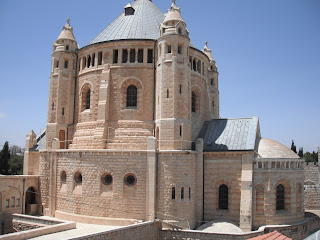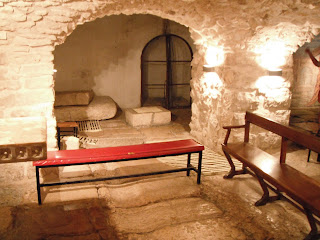Day 32: Shepherd’s Field, Herodian, Hebron, Tombs of the Patriarch
Hey everyone!
 Today was our final day of touring. It was a bittersweet moment, because part of me wanted to soak it all up because it was our last day and make the most of it. The other half of me was saying, “Really? One more day? I can’t wait for this to be over. I have had five weeks of this already and I am ready to go home.” But in the end, the day turned out alright.
Today was our final day of touring. It was a bittersweet moment, because part of me wanted to soak it all up because it was our last day and make the most of it. The other half of me was saying, “Really? One more day? I can’t wait for this to be over. I have had five weeks of this already and I am ready to go home.” But in the end, the day turned out alright. The day started out weird, with us waiting a half hour to make our bus arrangements for tomorrow. Miscommunication and confusion prevented us from solving it very quickly. We finally made it on the bus and departed for the fields. Our tour guide, while very nice and well meaning, was a devout Christian and gave us the stereotypical Christian tour, talking about how these were the actual fields the shepherds were in and these caves were exactly the caves the shepherds stayed in during Jesus’ time.
He tried to give us four “proofs”, but they just turned out to be (1) this land is Judah, (2) Jesus was here, (3) the Bible says so, and (4) tradition dictates this land is the land…. I am sorry, sir, but I don’t that word (“proof”) means what you think it means….
 We went to the Herodian where we found out that our tickets have expired, so we couldn’t get in. It was a small oversight on the behalf of our ticket holder, which frustrated us greatly.
We went to the Herodian where we found out that our tickets have expired, so we couldn’t get in. It was a small oversight on the behalf of our ticket holder, which frustrated us greatly. Later that afternoon, we tried to get into the Russian Orthodox Church and they locked us out, saying this place was a place of prayer and not a museum, and slammed the door in our faces. That really urked me. What kind of signal does that send people who are not Christians, slamming the door in their faces and not letting them into the church? I just wonder what Jesus would have done….
Despite these setbacks, we had a good day. We still visited Hebron and saw the tomb of the Patriarchs—the traditional site of the burial of Abraham, Isaac, Sarah, Leah, and Rebecca. The place was divided in half, half mosque, half synagogue. The Jews would not let us in on their side, but the Muslims let us in to see. It was interesting to see how both of these faiths, while so divided, still shared the same ancestry.
Afterwards we toured Hebron and shopped a bit in the local markets. We found out that Jewish settlers had come into Hebron in the 90’s and took over many sections of the land. Hebron is now a hot spot because of one specific event that will always live in the minds of the people here.
 In the late 90’s, one Jewish doctor settled in Hebron to try to make a living. After living there a while, he was fed up with all the Muslims living in the area, so he marched into the mosque that housed half of the tombs of the patriarchs and opened fire, killing around 20 people and injuring 80 more before the crowd swarmed him and killed him.
In the late 90’s, one Jewish doctor settled in Hebron to try to make a living. After living there a while, he was fed up with all the Muslims living in the area, so he marched into the mosque that housed half of the tombs of the patriarchs and opened fire, killing around 20 people and injuring 80 more before the crowd swarmed him and killed him. Immediately, the Israelis responded and set up defenses to keep their people safe before there were any repercussions. There were none, but the man who did the killing now has a tomb set up that is protected by the Israelis; it is like a shrine to the Jews here.
A few years later, the second Intifada broke out, and it was very nasty in this area. Many people died. It set back the community for a few years. In the aftermath, Israel set up certain streets to protect their citizens, making “sanitary streets” that the Palestinians are not allowed to walk on, only the Jews can walk on. Consequently, some Palestinians cannot leave the front doors of their homes because they are on the street. They are forced to climb down a ladder out their back window to exit their house every day.
 Continuing our walk, we stumbled into a market with huge tarps spread across all over. Our guide asked us what we thought the tarps were for. We answered, “Shade,” but he corrected us by telling us to look ontop of the tarps and seeing what is on top of them. Upon closer inspection, we saw large piles of trash piled up on top of the tarps. Our guide went onto explain that Jews have settled into many of the apartments in the area. Instead of depositing their trash like everyone else does, they feel it is their right to toss the trash out of the window onto the street below. The Palestinians walking by would get heaps of trash dumped on them daily, and because they are unable to do anything in retaliation, they erected the tarps to keep their merchandise and themselves safe.
Continuing our walk, we stumbled into a market with huge tarps spread across all over. Our guide asked us what we thought the tarps were for. We answered, “Shade,” but he corrected us by telling us to look ontop of the tarps and seeing what is on top of them. Upon closer inspection, we saw large piles of trash piled up on top of the tarps. Our guide went onto explain that Jews have settled into many of the apartments in the area. Instead of depositing their trash like everyone else does, they feel it is their right to toss the trash out of the window onto the street below. The Palestinians walking by would get heaps of trash dumped on them daily, and because they are unable to do anything in retaliation, they erected the tarps to keep their merchandise and themselves safe.These are the conditions people live in over there. All of the things I have told you I did not make up. These are real events dealing with real people. I cannot be the judge for you to make a decision on who to support or what to believe; I leave that decision to you. I will just tell the facts like I see it from here on out. If you want my personal opinion, feel free to ask, and I will calmly explain it to you. Until then, I wish you the best and pray that God blesses you richly.
Following His Call,
Adam
Romans 1:14
Romans 1:14


















